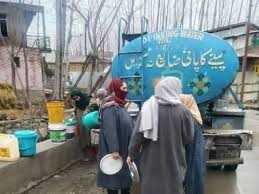
Kashmir, once known for its water resources from glacial springs to vast lakes, is now grappling with a looming water crisis. The natural reservoirs and wetlands, which acted as buffers against the scarcity, are now fighting for their mere existence.
A decade ago, hardly anyone could have imagined a place like Kashmir would face the water crisis. But the climate change, which led to erratic rainfall and shrinking of glaciers, and our behavior towards water ecosystems has led all of us to the unwanted dawn of Kashmir, where springs are drying up and snow-clad mountains are retreating faster than expected.
According to the government and some research estimates, Kashmir’s per capita availability of freshwater has been falling steadily. With agriculture consuming nearly 70% of the Valley’s freshwater. The water crisis is no longer a distant threat; it is a lived reality for thousands of households that face disturbed supply, contaminated taps, or rely on tankers.
Compounding this crisis is the alarming decline of Kashmir's wetlands. Wetlands, often regarded as “kidneys of Earth” for their role in filtering pollutants, regulating floods, and recharging groundwater, are themselves choking in Kashmir.
In 2024, the government admitted that nine wetlands in Kashmir failed to meet Class B water quality standards, making them unfit even for bathing and healthy aquatic life. Besides this, the elevated values of Biochemical Oxygen Demand (BOD), fluctuations in pH, sewage discharge, sedimentation, and reduced oxygen level—all these factors have reduced their capacity to store water, buffer floods, support biodiversity, and recharge groundwater.
Once majestically spread over 391,500 hectares (2011), the wetlands of Kashmir have shrunk to just 164,000 hectares in 2021, a loss of over 57% in just a decade. Dal has alone shrunk to 18 sq km from 22 sq km. The “Queen of Wetlands,” a RAMSAR site, has lost over 5.7 sq km in the last 4 decades.
The loss of these wetlands has not only impacted the availability of water resources and biodiversity but it has also impacted the livelihood of people too. Nadru harvesters, fishers, houseboat owners, and tourism operators all depend on healthy wetlands. Their decline threatens both jobs and traditions.
To secure Kashmir’s water future, it cannot be done without wetland restoration. The loss of wetlands is not just an ecological tragedy but a socio-cultural-economic one. If action is not taken now, Kashmir will be a region of scarcity from the region of shimmering lakes and gushing springs.
With political will, community involvement, and a scientific approach, the “Kidneys of Earth” can be revived, ensuring that the water
Email:--------------------tuhaq220@gmail.com
Kashmir, once known for its water resources from glacial springs to vast lakes, is now grappling with a looming water crisis. The natural reservoirs and wetlands, which acted as buffers against the scarcity, are now fighting for their mere existence.
A decade ago, hardly anyone could have imagined a place like Kashmir would face the water crisis. But the climate change, which led to erratic rainfall and shrinking of glaciers, and our behavior towards water ecosystems has led all of us to the unwanted dawn of Kashmir, where springs are drying up and snow-clad mountains are retreating faster than expected.
According to the government and some research estimates, Kashmir’s per capita availability of freshwater has been falling steadily. With agriculture consuming nearly 70% of the Valley’s freshwater. The water crisis is no longer a distant threat; it is a lived reality for thousands of households that face disturbed supply, contaminated taps, or rely on tankers.
Compounding this crisis is the alarming decline of Kashmir's wetlands. Wetlands, often regarded as “kidneys of Earth” for their role in filtering pollutants, regulating floods, and recharging groundwater, are themselves choking in Kashmir.
In 2024, the government admitted that nine wetlands in Kashmir failed to meet Class B water quality standards, making them unfit even for bathing and healthy aquatic life. Besides this, the elevated values of Biochemical Oxygen Demand (BOD), fluctuations in pH, sewage discharge, sedimentation, and reduced oxygen level—all these factors have reduced their capacity to store water, buffer floods, support biodiversity, and recharge groundwater.
Once majestically spread over 391,500 hectares (2011), the wetlands of Kashmir have shrunk to just 164,000 hectares in 2021, a loss of over 57% in just a decade. Dal has alone shrunk to 18 sq km from 22 sq km. The “Queen of Wetlands,” a RAMSAR site, has lost over 5.7 sq km in the last 4 decades.
The loss of these wetlands has not only impacted the availability of water resources and biodiversity but it has also impacted the livelihood of people too. Nadru harvesters, fishers, houseboat owners, and tourism operators all depend on healthy wetlands. Their decline threatens both jobs and traditions.
To secure Kashmir’s water future, it cannot be done without wetland restoration. The loss of wetlands is not just an ecological tragedy but a socio-cultural-economic one. If action is not taken now, Kashmir will be a region of scarcity from the region of shimmering lakes and gushing springs.
With political will, community involvement, and a scientific approach, the “Kidneys of Earth” can be revived, ensuring that the water
Email:--------------------tuhaq220@gmail.com
© Copyright 2023 brighterkashmir.com All Rights Reserved. Quantum Technologies